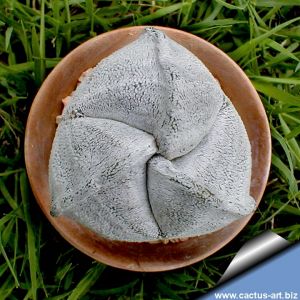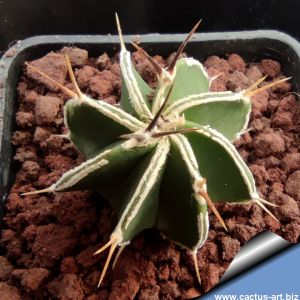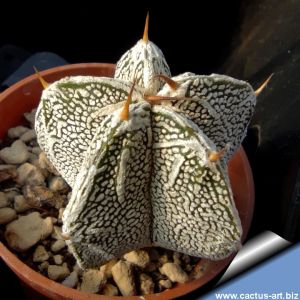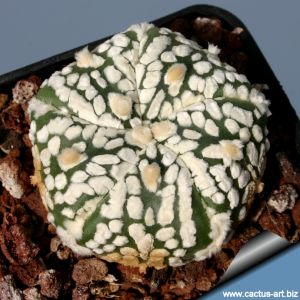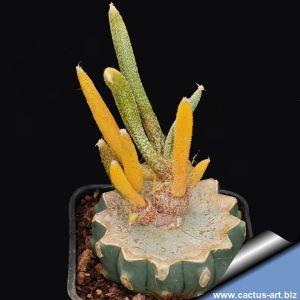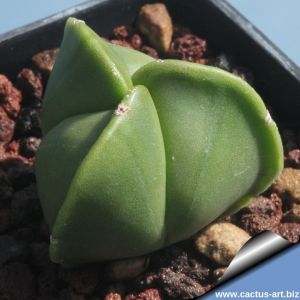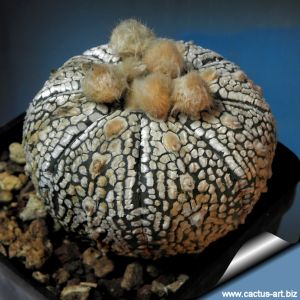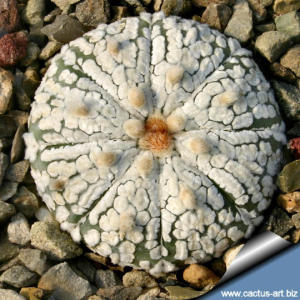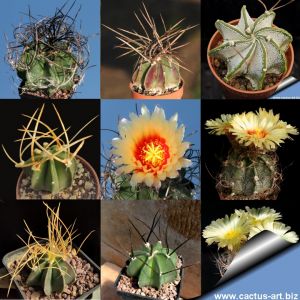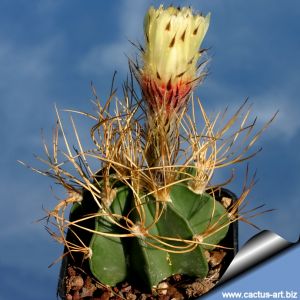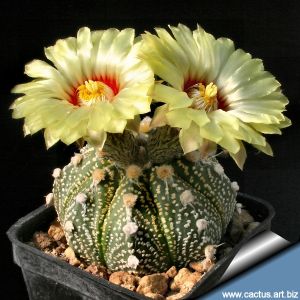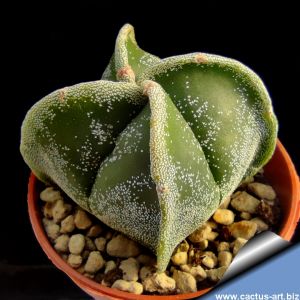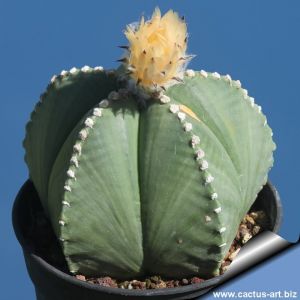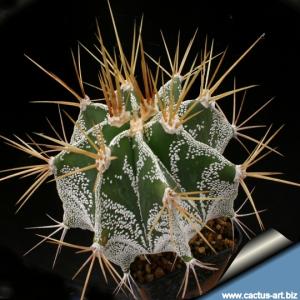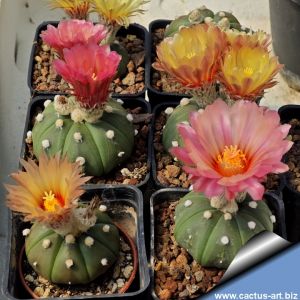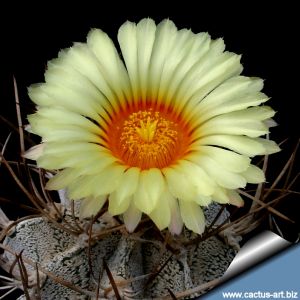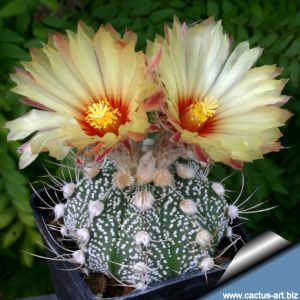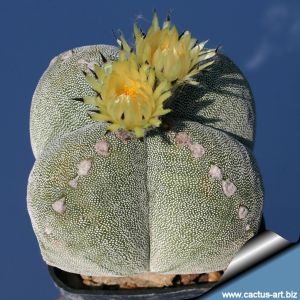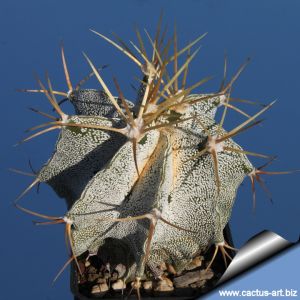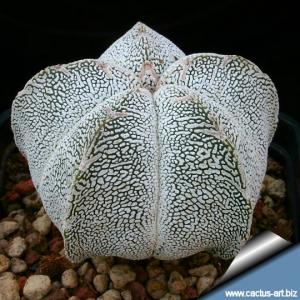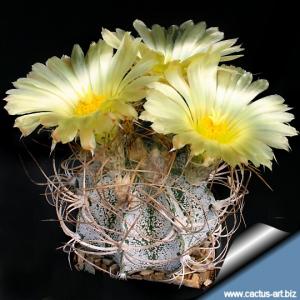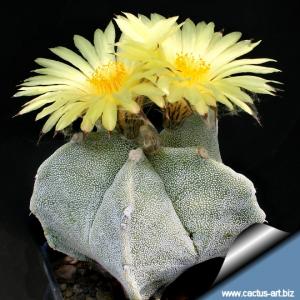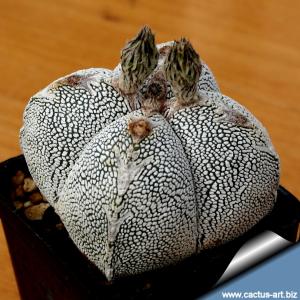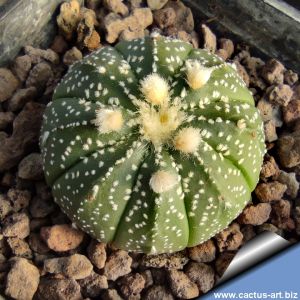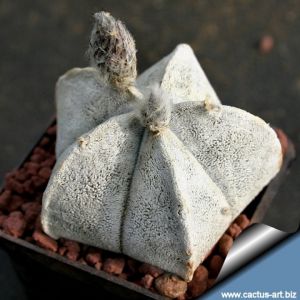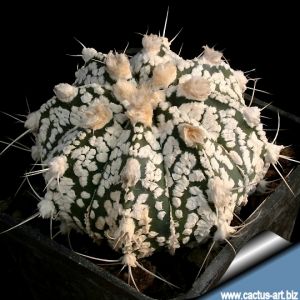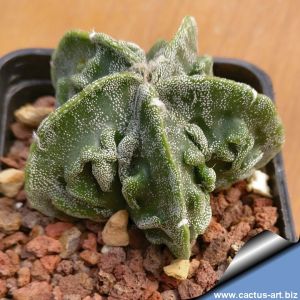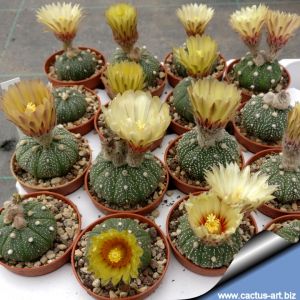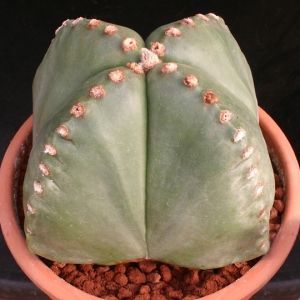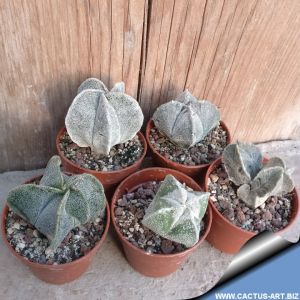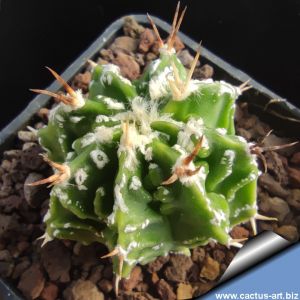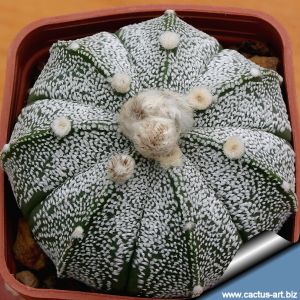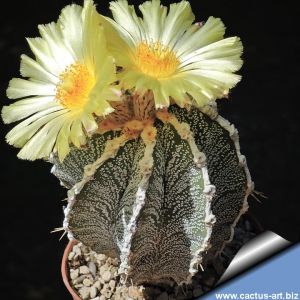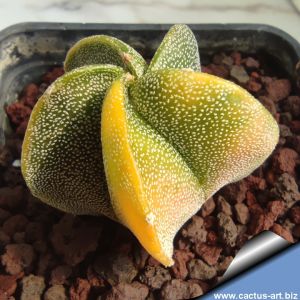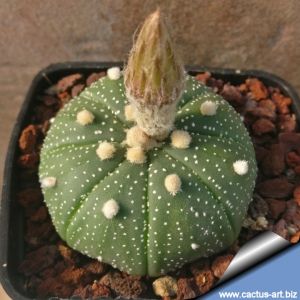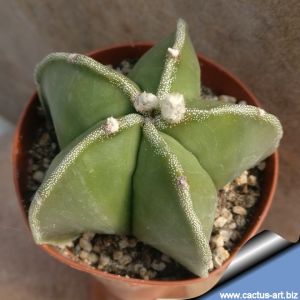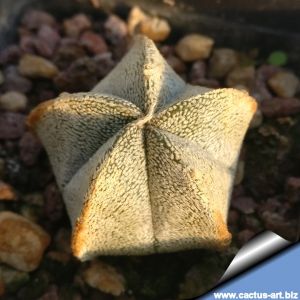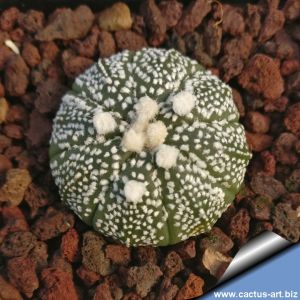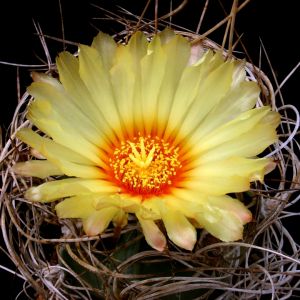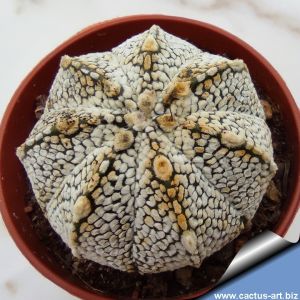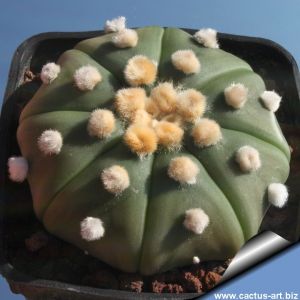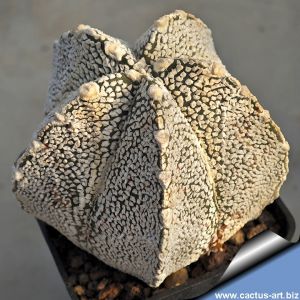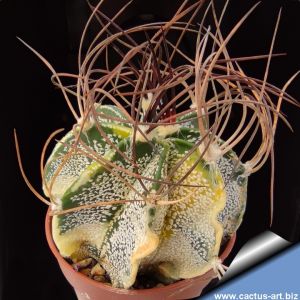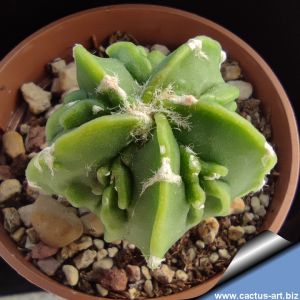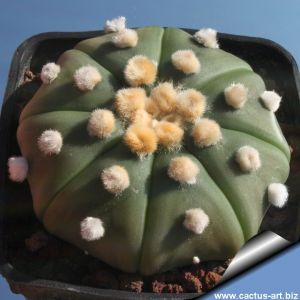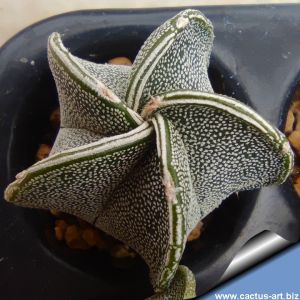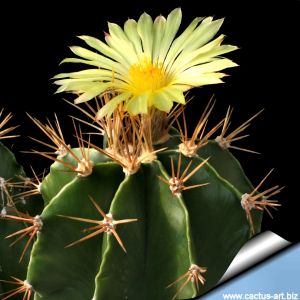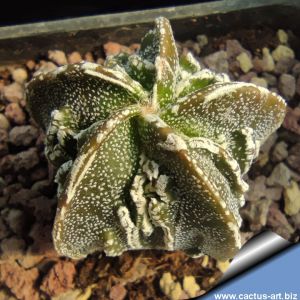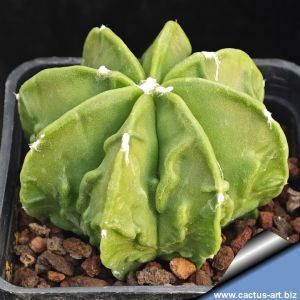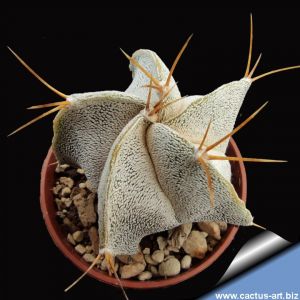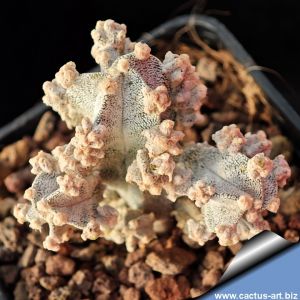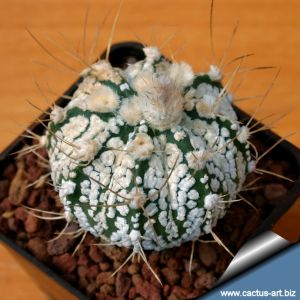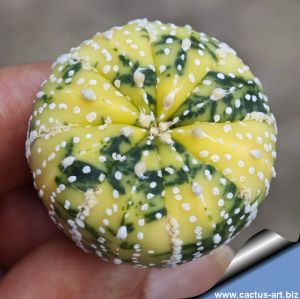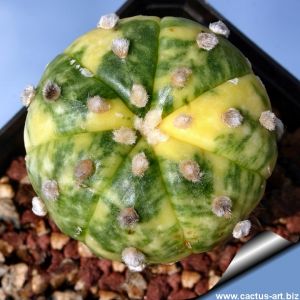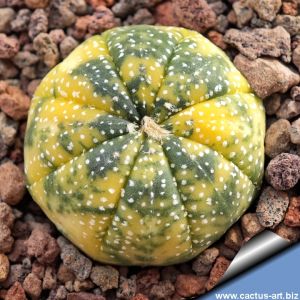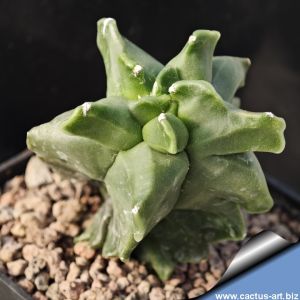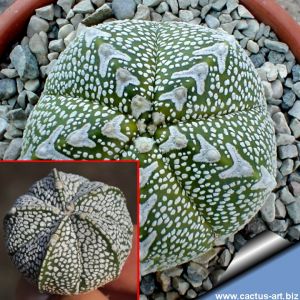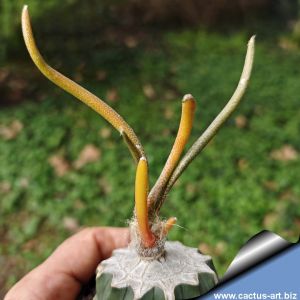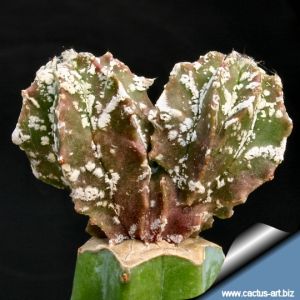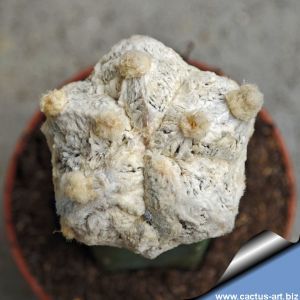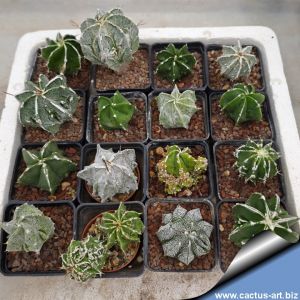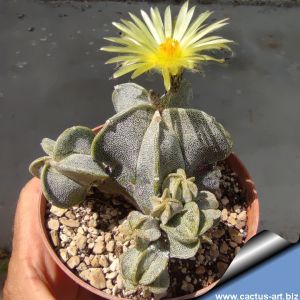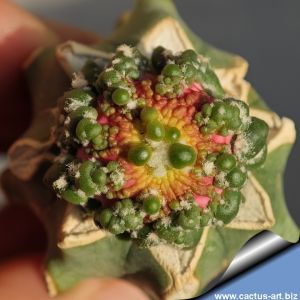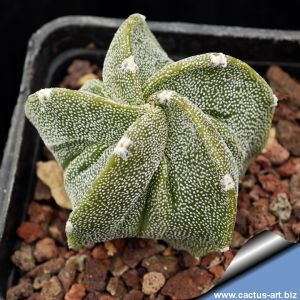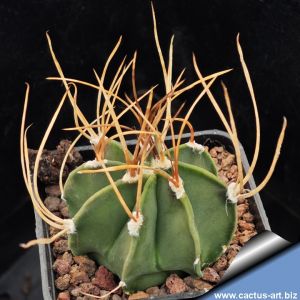-
1
Exceptionally rare: a genuine Coahuilense featuring just three ribs!!!
-
2
Japanese cultivar easily distinguished by its woolly areoles connected by a continuous felt-like line along the ribs. The smooth epidermis is green and lacks white flecking, making the pale lines stand out beautifully.
-
3
Interesting hybrid that combines the forms of A. ornatum with unique onzuka designs pattern. Very nice.
-
4
A special form with only 5 ribs — a rare trait in Astrophytum asterias and highly sought after by collectors.These selected specimens also display bold SUPERKABUTO-style markings. No two are alike.
-
5
Hybrid Astrophytum caput-medusae feature larger yellow and green tubercles that take on a lovely orange hue in winter, exhibiting vigorous and sturdy growth. Grafted specimens, truly stunning.
-
6
Astrophytum myriostigma "tricostatum nudum" is a strikingly pretty cultivar with only three ribs lacking the white flecks that cover the epidermis of the standard myriostigma, giving it a green, gray-green or mauve-green color overall depending on clones.
-
7
SUPERKABUTO classical form. Diameter 4-5 cm, seed grown about 5 years old (own roots never grafted).
-
8
Esemplari selezionati di A. asterias cv. SUPERKABUTO, solo piante con grandi macchie bianche e disegni particolari. Diametro 4-5 cm, piante da seme di cica 5 anni di età su radici proprie.
-
9
A curated mix of Astrophytum capricorne — a highly variable and strikingly beautiful species. Each plant is unique, showcasing diverse stem colour and mottlings, textures, and spines colors. An interesting selection at an affordable price.
-
10
A cactus of striking beauty and originality, featuring a green body adorned with long, twisted golden spines. Its large yellow flowers with a vivid red throat enhance its unique charm.
-
11
AS-CAP hybrids – Cross between A. asterias (mother) × A. capricorne (pollen donor). Large flowers with pearl-yellow petals and fiery red throat, ribs more pronounced than pure asterias but with short spines. A balanced blend of both species’ best traits.
-
12
Beautiful selected specimens with tetragonal growth (form quadricostatum), featuring faintly dotted epidermis that forms intricate patterns. The visual effect is elegant and refined.
-
13
Beautiful form that only deviate from the well-known typical form for lacking or mostly lacking white flecks, giving a bright green colour. It is by some considered an extreme form of the subspecies potosinus.
-
14
The Astrophytum ornatum is the largest and easiest to grow and also the fastest of the Astrophytums. Spherical when young to columnar when mature, some specimen develop nice twists with age.
Ribs have characteristic cross bands of wooly scales.
-
15
Glossy green stem without dots accentuates white areoles. Blooms range from pearl-yellow to soft pink, all with crimson centers. A visual delight for succulent enthusiasts.
-
16
The Astrophytum capricorne v. niveum, named "niveum" (snow) for its white stem, has bright flecks that intensify in the sun. It blooms profusely in summer with yellow flowers and a red throat, offering a striking contrast.
-
17
CAP-AS hybrids – Blend of A. asterias and A. capricorne: slightly raised ribs and large creamy-yellow flowers with pearly sheen and red throats. Variable traits, strikingly beautiful.
-
18
A beautiful and distinctive plant: A. myriostigma quadricostatum differs from the typical, more common form by having four ribs instead of five.
-
19
Nearly all-white body covered in a dense scattering of white dots, producing a glowing appearance. Vivid yellow blooms contrast dramatically against the pure white surface.
-
20
Astrophytum coahuilense with five ribs, has a surprising similarity to Astrophytum myriostigma. However, it is different in all characteristics regarding flower, fruit and seed. Flowers are yellow with a red center (like those of Astrophytum capricorne).
-
21
-
22
Astrophytum capricorn v. Crassispinoides is a form of A. capricorne v. minor flowering with a pure yellow flower. The spines are creamy white, yellowish or tan, thin, soft and curled. It is really beautiful and unmistakable even without flowers.
-
23
-
24
"Onzuka Ranpo-gyoku". ONZUKA has fabulous markings that varies considerably from plant to plant, and also plants change their appearance in age and they are full of surprises as they grows. The “quadricostatum” form has 4 ribs instead of 5.
-
25
-
26
Five ribs and a striking resemblance to A. myriostigma. Different in terms of flower, fruit and seed which resemble the Astrophytum capricorne. Stems covered with tiny fluffy, wool-like flecking for a velvety appearance.
-
27
This plant is an example of crossbreed involving Astrophytum coahuilense x Astrophytum asterias; the resulting interspecific F1 hybrid shows intermediate characteristic from both the parents, the 5 ribs are inherited by the female parent. On the contrary,
-
28
Hybrid A. asterias 'Superkabuto' x A. capricorne. This hybrid inherited large white spots from “Superkabuto”.The ribs are also noticeably raised, clearly indicating kinship with A. capricorne. The flower are also very beautiful.
-
29
"Fukuryu Rampowgyoku". FUKURYU is a Japanese word that would mean presence of additional ribs. It forms small extra ribs, usually these additional ribs have not areoles and develops on the lateral side sandwiched between two contiguous true ribs.
-
30
-
31
-
32
-
33
-
34
Crossbreed involving two different Astrophytum species (Astrophytum asterias x Astrophytum coahuilense) the resulting interspecific F1 hybrid shows intermediate characteristic from both the parents, the number of ribs vary from 5 to 8.
-
35
Unlike typical OR-MY hybrids, this cultivar shows no or minimal white spotting, displaying a solid green hue that ranges from bright to blue-, gray-, or mauve-green across clones.
-
36
The woolly areoles on the ribs have a felty line between them so it seems like the areoles are connected with each other.
-
37
Green star-shaped body, with variegated areas from yellow to pink-purple. Each plant is particular, with a combination of colors and patterns that make it unique.
-
38
Variegated plants have sectors, patches or stripes with two or more colours. Plants with variegated body are highly prized. Each specimen different and particular.
-
39
Astrophytum asterias is small, round, spineless and squat cactus. The disc-shaped body is divided into 8 ribs, greenish-brown and may appear speckled from its covering of white scales. The flowers of this cactus are yellow with red red bases.
-
40
Astrophytum myriostigma var. subnudum (partially naked form) is similar to A. myriostigma nudum, but deviates from it for having only a few white spots. The spots often form nice patterned designes on the dark green body.
-
41
-
42
Astrophytum asterias cv. Ooibo is similar to the standard A.asterias, but it has very large characteristic and woolly areoles. So it is easily distinguishable from the common asterias that has relatively small scarcely woolly greys-white areoles.
-
43
Astrophytum senile is a variety of A. capricorne that has beautiful yellow flowers with a red center and long flexible spines so densely wrapped that the body is barely visible and looks like a bundle of dry grass.
-
44
Hybrids from controlled pollination of ♀A. asterias "Superkabuto" × ♂A. coahuilense. Typically show 8 sharper ribs than Superkabuto (clearly expressing coahuilense traits), with stems covered in large white wool-like flecking. Stunning intermediate forms.
-
45
(Seedling on its own roots) This is a Japanese selected strain with very large characteristic and woolly areole in combination with the green epidermis of "RURI KABUTO" (nudum). It is one of the most famous and peculiar Japanese Astrophytum cultivars.
-
46
NEW RELEASE! Beautiful Thai selection with prominent woolly spots creating a crisp white pattern on the ribs. Stock is very limited, and additional availability cannot be assured.
-
47
Variegated plants have sectors, patches or stripes with two or more colours. Plants with variegated body are highly prized. Very variable.
-
48
(Type B - HEKIRAN FUKURYU + RURI KABUTO) The Japanese term FUKURYU indicates the presence of small lateral rib-like protrusions, lacking areoles, that develop between two main ribs. Meanwhile, RURI refers to smooth-bodied individuals without dots.
-
49
This particular cultivar differs from the typical A. asterias due to the starry rather than rounded stem and the large felted areoles. The skin is dull green and smooth.
-
50
The Japanese HAKU-JO cultivar features fuzzy areoles along its ribs, forming a double felt line that makes it appear as though the areoles are linked together.
-
51
-
52
Rare variety that combines the irregular ribs of FUKURYU with the felt lines of HAKU-JO on the edge of the ribs. As the plants get older they become more and more beautiful.
-
53
(HEKIRAN FUKURYU Type B + RURI KABUTO) Distinguished by unique supplemental rib structures and naked body without dots.
"multicostatum" = 6-7 (or more) ribs.
-
54
A rare Astrophytum cultivar combining a three-ribbed (tricostate) form with dense, irregular white flecking (ONZUKA pattern) . A special plant highly sought after by collectors for its clean, sculptural look. Each specimen has a unique pattern.
-
55
Plants obtained by controlled pollination of Astrophytum myriostigma x Astrophytum ornatum. Ribs are sharp usually 5 (like in A. myriostigma) spineless or with variable spines.
This hybrid are strong growing. The flower are also very beautiful.
-
56
Rootted cuttings not grafted.
-
57
Hybrid A. capricorne x A. asterias 'Superkabuto'. This hybrid inherited large white spots from “Superkabuto”.The ribs are also noticeably raised, clearly indicating kinship with A. capricorne. The flower are also very beautiful.
-
58
-
59
These plants merge the vivid yellow, orange, or reddish variegation of “NISHIKI” against a deep green base with the “RURY KABUTO” (nudum) type, known for its absence of white dots. Every specimen is one-of-a-kind, displaying uniquely decorative designs.
-
60
The Japanese cultivar “Nishiki” stands out for its vibrant yellow, orange, or reddish variegation against a dark green background, creating unique, high-impact patterns. An iconic and essential plant for any collection.
-
61
Selected form with very elongated tubercles. Graceful and distinctive. Grown from seed, quite variable. Japanese cultivar still quite rare in collection, seldom offered for sale.
-
62
This plant is an example of a cross between two of the most popular Astrophytum cultivars (Astrophytum asterias "SUPERKABUTO" x Astrophytum myriostigma "ONZUKA"); the resulting interspecific F1 hybrid shows intermediate characteristics from both parents.
-
63
A remarkable hybrid of Astrophytum caput-medusae and A. myriostigma, featuring shorter and chunkier tubercles than A. caput-medusae. Exceptionally rare, with extremely limited availability. Grafted specimen.
-
64
Thin, elongated tubercles, mottled with yellow and green, which take on a lovely pinkish-red hue in winter. Grafted plants, very beautiful.
-
65
Beautiful Japanese cultivar with characteristic cloud-like white patches on a smooth green body. The pattern creates a soft, artistic contrast.
-
66
A dream Myriostigma! The cottony dots are so densely packed they form a continuous, seamless covering. The effect is delicate, elegant, and hypnotic, with a smooth, velvety texture that draws the eye and holds attention.
-
67
Extraordinary hybrids result of complex crossbreeding between diverse Astrophytum (e.g., asterias, capricorne, myriostigma) and mutant forms like Superkabuto, Onzuka, or Fukuryu. Each specimen showcasing unpredictable combinations of patterns and shapes.
-
68
Atypical variety that grows in a branching pattern, sprouting new shoots from the areoles and forming small clusters over time.
-
69
Japanese cultivar with raised conical tubercles resembling a tortoise shell (hence the name "Kitsu-kow"). This special clone frequently features bright pink new growth, adding an extra layer of visual appeal. CLONE 1, GRAFTED:
-
70
Type A: This is the most common form with small, partially developed extra ribs. Typically, these small additional ribs do not reach the apex of the plant, lack areoles, and develop on the lateral side, situated between two adjacent true ribs.
-
71
Plant with sharp green/bluish ribs sometimes tinged with purple without white flakes. Spines golden yellow or amber, long and pointing in all directions, often so densely nest wrapped that the body is barely visible and looks like a bundle of dry grass.
-
72
Long spines in a golden-brown hue and yellow blooms.

